Washing machines are key foundational pillars within a home. Whether someone lives alone or with their partner and three children, this piece of technological innovation makes sure we don’t spend hours a day washing every piece of clothing we own by hand. Can you imagine how long it would take with four or five family members tossing in additional garments? As with any appliance that deals with water, though, mold in a washing machine is a health hazard that can easily occur in any home.

Once this fungus among us settles into our favorite house appliance, it then leads to a chain reaction. Not only is the surrounding indoor air quality lowered, but every piece of clothing put into the wash is then blasted with moldy particles. Talk about an icky situation and one that can seriously impact our health.
To keep that appliance running in tiptop shape and our clothes sparkly clean and unaffected by this indoor contaminant, it’s crucial to understand how to prevent mold in a washing machine and what to do if it ever pops up in your home.
Let’s dive in.
What’s the Deal With Mold?
But first, the lowdown on mold. You can’t fight an enemy without knowing all of the juicy details about them.
When it comes to mold, there are 100,000 species identified so far across the planet, and they all reproduce by creating microscopic spores.¹’² It’s similar to how a dandelion puff produces those fluffy white seeds. Like the cloud-like seeds, these spores will catch the air current to wherever it leads, and they will remain spores (non-living particles) until they find a habitable surface with the elements they need to transition into a living mold colony.
The four components a mold spore needs to live are:³
- Oxygen: this barely counts because they need so little
- Temperature: 40-90 degrees Fahrenheit is preferred but many species can live in extremes
- Food: like raccoons, they eat almost everything
- Moisture: the often missing ingredient
Given these elements for 24–48 hours, a mold spore will put down roots called hyphae and begin growing. Once established, it will begin to release more spores, starting the cycle all over again.
Can Mold Grow in a Washing Machine?
Absolutely. With mold existing everywhere, it’s impossible to avoid spores making their way into a home. They could zip right in through the front door, catch a ride on the dog’s fur, or get tracked in by shoes. Once inside, they’ll bounce around and ride the air current to wherever that leads throughout the house. Sometimes, it ends up leading straight into that washing machine, a perfect little moldy dream home.
Going back to the components above, food and moisture are the main two elements generally needed for a spore to start growing. When it comes to the washing machine, water availability is a given: every time you turn on the machine, that box gets checked off. As for food, there are plenty of options between particles on clothing, laundry detergent left behind, mineral buildup, or excess fabric softener. That’s not even including the random particles like dust and organic matter that can fly in at any given time.
If this ideal environment exists for at least 24 hours, a spore can start growing, and mold in a washing machine is established.
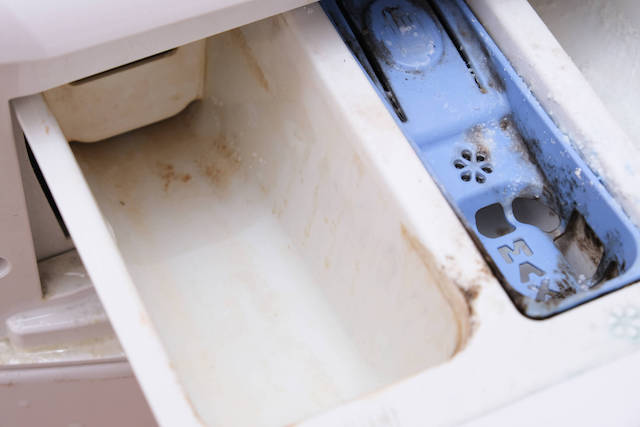
This event leads to a massive increase in harmful particles in the washing machine itself, on the clothes that go inside of it, and into the air in the surrounding area; all of which is not good for our health. Some species of mold also release microscopic particles called mycotoxins when they feel threatened, further contaminating that indoor space.⁴
And, just for a little extra particle pazzazz, bacteria could also be joining the party too.⁵
What Kind of Mold Grows in a Washing Machine?
The short answer: with over 100,000 species existing in nature, quite a few could be existing within that washing machine.
With so many species of mold existing across the planet, every ecological space outside of the home is unique. That means that a widely random assortment of spores can make their way into a home at any given time and start causing problems. If the conditions mentioned above are met, any one of those spores can start growing in the washing machine.
Hence, why any mold in a washing machine should be handled the same way: remediated quickly and properly. You never know how someone will respond to exposure to this indoor contaminant.
Mold in a Washing Machine: A Hidden Health Hazard
As mentioned above, mold exists everywhere, which helped lead to the popular misconception that mold exposure is "no big deal." That’s absolutely not true.
Yes, we all encounter a few moldy particles throughout the day; it’s inevitable. They’re just invisible to the naked eye, so we would never know. Their small size, though, allows them to enter our bodies, which is where the hazard part comes in.
Measured in a unit called a micron, which is one-millionth of a meter, spores and mycotoxins are small enough to be inhaled, ingested, or absorbed into the skin. The EPA categorizes these types of particles as particulate matter and splits them into two groups.⁶
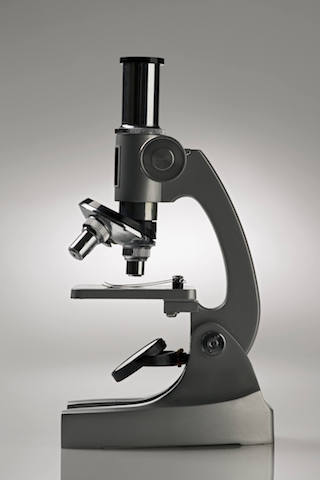
These two categories are:
- PM₁₀: particles with diameters of 10 micrometers (microns) or less
- PM₂.₅: fine particles with diameters of 2.5 micrometers or less
When a few of these enter the body throughout the day, the immune system tags them as foreign particles, descends, and gets rid of them in a jiff. Typically, it’s not a problem. When a mold colony exists within a home, though, the body is no longer facing a few particles, it’s facing an army of them. Every time you or a family member is in the building, every breath taken or surface touched is another opportunity for these particles to make their way inside of the body.
Seeing as how the average person breathes 20,000 breaths a day and most of those are taken within their homes, that’s a lot of opportunities for exposure.⁷ When it comes to mold in a washing machine, it’s not just the air we have to worry about either; the clothes we wear are also covered in particles as well, further increasing the level of exposure.
The interesting thing about mold is that no two people react the same way to exposure. While one individual may have an occasional headache, another may develop 17 symptoms. Factors such as genetics, the presence of mycotoxins, species of mold, immune system status, and preexisting conditions all play a role. ⁸’⁹’¹⁰’¹¹’¹²
Some symptoms of mold exposure include:
- Headache
- Hair loss
- Digestive issues
- Rashes
- Coughing
- Neurological issues
- Runny nose
- Brain fog
- Respiratory problems
- Chronic fatigue
Researchers are still looking into exactly how this indoor contaminant affects the body, but what they do know is that individuals with compromised or developing immune systems are at greater risk of developing symptoms faster and to a greater extent. Exposure can also work in tandem with other autoimmune conditions such as Lyme and the Epstein-Barr Virus, making those that are exposed feel even more ill.
This potential for a wide range of symptoms is why it’s important to know how to handle mold in a washing machine and what to do to prevent it from occurring in the first place.
How To Tell If There’s Mold in a Washing Machine
Not all mold growth has a neon sign pointing at it announcing that it’s present. Sometimes, hidden mold growth can occur in hard-to-reach areas or in places we don't frequent often. Essentially, you can't just rely on what you see to determine if there’s mold in a washing machine. Other senses can help dictate if there’s a problem as well.
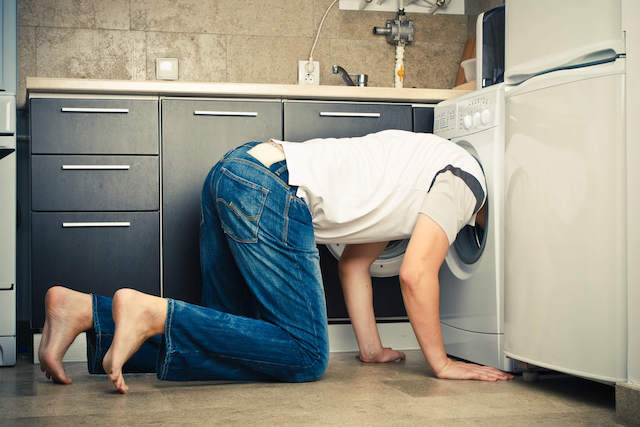
Visual Inspection
The first step to figuring out if you’ve got mold in a washing machine is to grab a flashlight and take a close look inside. The areas inside of the machine you should check include the lid, the detergent drawer, the inside of the machine, the rubber gasket (for front loaders), and any other crevice you can access. With so many species out there, mold can come in all sorts of colors, shapes, and textures, so look for any sort of abnormality.
Any growth you see means it’s time to jump into remediation.
The Sniff Test
If you don’t find any visible mold, that doesn’t mean that there isn’t a problem. Thanks to a mold spore’s small size, growth can go on for some time before the particles are large enough to be visible to the naked eye. Or, there could be a sneaky colony growing somewhere that’s extremely difficult to see.
In this case, rely on your nose. Mold growth often creates a damp, musty, earthy smell that indicates a problem within.
Do You Feel Okay?
Neither of those boxes is checked off, but do you still suspect a problem? First of all, always listen to your intuition! When it comes to indoor mold growth, instinct is a powerful tool to ensure our indoor spaces are safe and promote healthy living.
Our bodies are amazing warning systems that will let us know when something is wrong. If you start feeling unwell every time you put on your clothes, do the laundry, or hang out near the machine, that can point to a moldy issue. Those invisible particles could be making their way inside of your body and wreaking havoc, causing your body to sound the alarm and push for you to get out of that situation.
How to Get Rid of Mold in a Washing Machine
Once you’ve established that there’s suspicious activity in your washing machine, it’s time to grab those supplies and get to work. Don’t go for the bleach, though!¹³ This cleaner is not your friend when it comes to mold because it can leave particles behind. Any mold particles, even dead ones, can allow exposure to continue and health reactions to persist. You want a cleaning product that will also help to remove the mold by the roots and lift up particles from the surface they're stuck on.
Products You Will Need:
- Protective gear: gloves, a mask, and goggles
- Botanical cleaners: EC3 Laundry Additive and white vinegar are my suggestions
- Microfiber towels: these are 100 times better at wiping away small particles
- A spray bottle: to hold your cleaning product
- A scrubby brush: for hard to reach areas
Once you’ve got everything together, you can start that attack.
Here are the steps to getting rid of mold in a washing machine:
- Put on your protective gear
- Place the white vinegar in the spray bottle
- Pull out the detergent tray and soak in vinegar for at least half an hour
- Spray the entire washing machine down, including the inside of the drum, the rubber gasket, the lid, and any other part you can reach
- Allow this to sit for at least half an hour
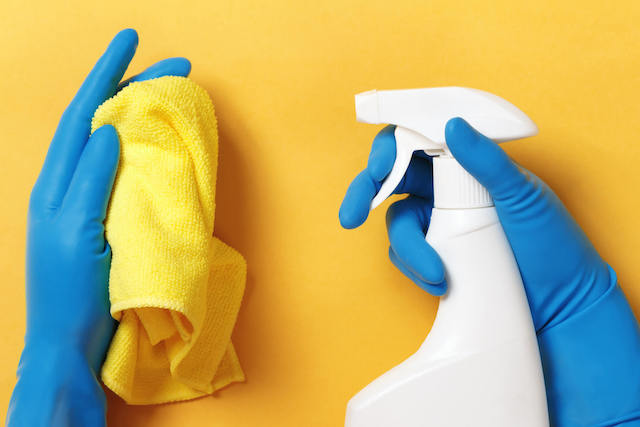
- Wipe everything down with microfiber towels, making sure to alternate them so you’re not spreading the moldy particles around
- Gently scrub the detergent tray, wipe with a microfiber towel, and replace it in the machine
- Place two cups of white vinegar in the washing machine and run it on the hottest cycle (if it has a sanitizing or self-clean cycle, use this)
- Complete the spray and wipe down process once more (mycotoxins and bacteria are incredibly difficult to remove, so the more thorough the better)
- Place EC3 Laundry Additive into the detergent tray and run the machine on the hottest cycle
- Run one more cleaning cycle to ensure the particles are gone
- Spray the outside of the machine with white vinegar or Benefect Decon 30, let it sit for about 30 seconds, and then wipe with a microfiber towel
- Open the door and detergent tray and allow the machine to completely dry
The process above may seem thorough, but you want to make sure that all growth and spores are removed so the mold doesn't come right back and other hard-to-remove particles like mycotoxins and bacteria are gone. Especially if you or a family member is experiencing hypersensitivity from exposure. At the end of the day, a safe washing machine that isn’t contaminating everything in the home is the ultimate goal.
If that growth comes right back, it could indicate a bigger problem, like mold behind the drum or a hidden colony elsewhere in the home. A high volume of spores in the indoor space increases the chances of them opportunistically growing elsewhere. One mold problem can easily turn into three or four throughout the home. In this case, you can try the cleaning process again, but it’s best to call in a professional mold inspector to come in and see what the situation is.
Again, the ultimate goal is a safe appliance and a healthy indoor environment.
How to Prevent Mold in a Washing Machine
The best way to deal with mold in a washing machine is to prevent it from occurring in the first place. The good news is that there are many ways to help avoid this fungus among us from creating a moldy clothing catastrophe.
A few steps to prevent mold in a washing machine include:
- Leave the lid open and the detergent tray open when not using the machine: this reduces moisture trapped within the machine and allows for airflow
- Wipe down the seals after washing: this removes pooled moisture
- Use the right detergent: if it calls for high-efficiency products that’s what you should go with. Too many suds can leave the door wide open for mold growth
Use EC3 Laundry Additive with every use: this will help remove particles like spores from clothing and the washing machine itself
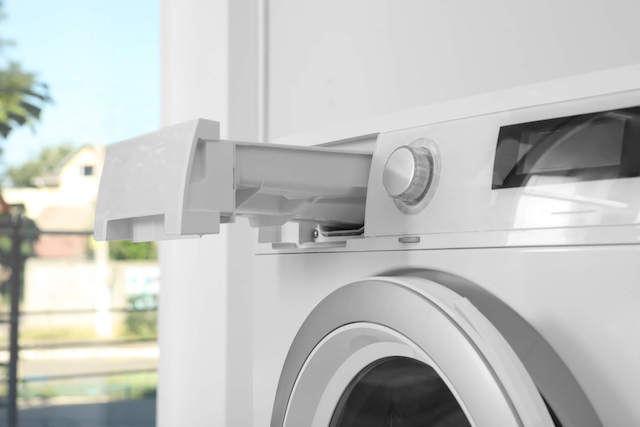
- Clean the rubber gasket and lid seals once a week with white vinegar and a microfiber towel: this helps remove any particles that managed to sneak inside and residue from the detergent
- Maintain indoor humidity between 30-50%¹⁴: turn on an exhaust fan, open a door or window to create airflow, or invest in a dehumidifier to help
- Deep clean the machine once a month using white vinegar and the cleaning steps above: this helps remove any contaminants and residue inside and helps the machine operate at peak efficiency
- Inspect for wear, tear, and leaking: a malfunctioning machine can lead to excess moisture and mold growth so replace any parts like the hoses as needed or call a repair technician to come in and fix the problem
- Adhere to the life expectancy: when the malfunctioning starts ramping up, it’s time to move on to a new machine that’s not a moldy dream home
- Remove wet clothes immediately: remember, all it takes is 24 hours for a mold spore to grow
This isn’t an exhaustive list, but it’s a great place to get started on ensuring mold in a washing machine doesn’t happen in your home.
Mold-Free Laundry
Whether you love or hate laundry day, no one wants to deal with mold in a washing machine and the health effects it can cause. Life is hard enough without having to throw on moldy clothes too. That’s why adding mold prevention to your cleaning routine is so important, as is knowing what to do if a moldy catastrophe ever happens.
While society doesn’t often consider how environmental factors affect health, that doesn’t mean that they can’t cause problems. Maintaining a safe home free from mold growth helps ensure you and your family remain healthy. Plus, a moldy washing machine is just gross! Eau de mold is not what we want our clothing to smell like.

Health begins at home.™
Citations:
- Environmental Protection Agency. (n.d.). Mold. EPA. Retrieved from https://www.epa.gov/mold.
- Centers for Disease Control and Prevention. Basic facts about mold and dampness. Centers for Disease Control and Prevention. Retrieved from https://www.cdc.gov/mold/faqs.htm.
- Lstiburek, J., Brennan, T., & Yost, N. (2002, January 15). Rr-0208: What you need to know about mold. Building Science Corporation. Retrieved from, https://www.buildingscience.com/documents/reports/rr-0208-what-you-need-to-know-about-mold/view.
- World Health Organization. (n.d.). Mycotoxins. World Health Organization. Retrieved from https://www.who.int/news-room/fact-sheets/detail/mycotoxins.
- Jacksch, S., Zohra, H., Weide, M., Schnell, S., & Egert, M. (2021). Cultivation-based quantification and identification of bacteria at two hygienic key sides of domestic washing machines. Microorganisms, 9(5), 905.
- Brown, A. (2014, April 28). How Many Breaths Do You Take Each Day? [web log]. Retrieved from How Many Breaths Do You Take Each Day?
- Environmental and Occupational Health Assessment Program, & Environmental and Occupational Health Assessment Program, & Health Science Section, Mold Basics for Primary Care Clinicians (2009). Hartford, CT; Connecticut Department of Public Health. , H. S. S., Mold Basics for Primary Care Clinicians 1–10 (2009). Hartford, CT; Connecticut Department of Public Health.
- Curtis, L., Lieberman, A., Stark, M., Rea, W., & Vetter, M. (2004). Adverse health effects of indoor molds. Journal of Nutritional & Environmental Medicine, 14(3), 261-274.
- Bush, R. K., Portnoy, J. M., Saxon, A., Terr, A. I., & Wood, R. A. (2006). The medical effects of mold exposure. Journal of Allergy and Clinical Immunology, 117(2), 326-333
- Fisk, W. J., Lei-Gomez, Q., & Mendell, M. J. (2007). Meta-analyses of the associations of respiratory health effects with dampness and mold in homes. Indoor air, 17(4), 284-296.
- Wild, C. P., & Gong, Y. Y. (2010). Mycotoxins and human disease: a largely ignored global health issue. Carcinogenesis, 31(1), 71-82.
- EPA. (n.d.). Health and Environmental Effects of Particulate Matter (PM). EPA. Retrieved from https://www.epa.gov/pm-pollution/health-and-environmental-effects-particulate-matter-pm.
- EPA. (n.d.). Should I use bleach to clean up mold? EPA. Retrieved from https://www.epa.gov/mold/should-i-use-bleach-clean-mold.
- EPA. (n.d.). A Brief Guide to Mold, Moisture, and Your Home. EPA. Retrieved from https://www.epa.gov/mold/brief-guide-mold-moisture-and-your-home#tab-6.
